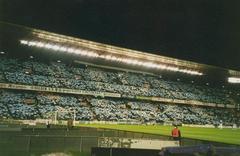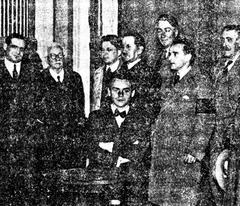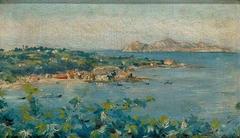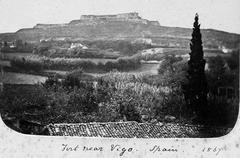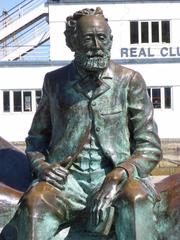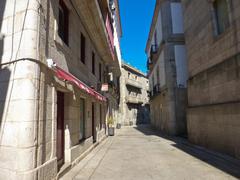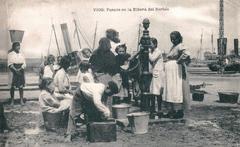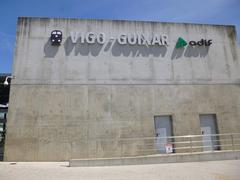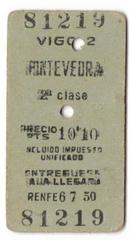
Edificio El Moderno, Vigo, Spain: Visiting Hours, Tickets, and Historical Site Guide
Publication Date: 04/07/2025
Introduction
Standing at the lively intersection of Rúa Policarpo Sanz and Rúa Carral, Edificio El Moderno is one of Vigo’s foremost architectural icons. Commissioned at the turn of the 20th century by Manuel Bárcena Franco, Count of Torrecedeira, and designed by the French architect Michel Pacewicz, this building reflects Vigo’s dynamic transition from a coastal fishing town to a cosmopolitan industrial city. The structure’s richly ornamented façades—blending French Baroque, Rococo, and Modernist influences—offer a testament to the city’s embrace of European modernity. Though primarily a private building today, Edificio El Moderno’s striking exterior remains a must-see for visitors, drawing architecture enthusiasts and travelers interested in Vigo’s historical and cultural evolution (Wikipedia; LovingVigo; Concello de Vigo; Minube).
Contents
- Introduction
- Historical Background
- Origins and Commissioning
- Architectural Context and Style
- Evolution and Historical Uses
- Renovations and Alterations
- Significance in Vigo’s Urban Development
- Preservation and Cultural Recognition
- Visitor Information
- Visiting Hours and Tickets
- Accessibility
- Getting There
- Photographic Tips
- Guided Tours and Special Events
- Nearby Attractions
- Frequently Asked Questions (FAQ)
- Conclusion
- Sources and Further Reading
Historical Background
Origins and Commissioning
Edificio El Moderno was conceived during a period of rapid economic growth in Vigo. The Count of Torrecedeira sought to symbolize this new prosperity with a building that would stand as an urban landmark. Construction began in 1897, led by Michel Pacewicz, whose Parisian architectural sensibilities deeply influenced the city’s landscape. The building was completed in 1902 (Wikipedia; Patrimonio Galego).
Architectural Context and Style
The building is a masterful example of late 19th-century eclecticism, drawing from French Baroque, Rococo, and Modernist styles. Its two main façades, facing Policarpo Sanz and Carral, are adorned with grand Corinthian columns, floral garlands, and iron balconies. The rounded corner—originally topped with a chromatic dome—serves as a distinctive visual anchor (Concello de Vigo; Patrimonio Galego).
Evolution and Historical Uses
Beginning as a rental residence, Edificio El Moderno was converted into a hotel in 1906, quickly becoming a social and cultural hub. Notable guests included actor Fernando Díaz de Mendoza y Aguado, who passed away at the hotel in 1930. In 1953, the building was renovated into the Gran Hotel, reflecting the city’s evolving needs (Wikipedia).
Renovations and Alterations
Significant renovations occurred in 1977, when architect Desiderio Pernas altered the interior, added new floors, and removed the original dome. While these changes were controversial, many decorative elements—such as the ornate balconies and floral motifs—were preserved, maintaining the building’s Belle Époque character (Wikipedia; Patrimonio Galego).
Significance in Vigo’s Urban Development
Edificio El Moderno is emblematic of Vigo’s transformation into a modern city. Together with other works by Pacewicz, it helped define the architectural identity of central Vigo, particularly around Puerta del Sol (HollyMelody; Viajes La Voz de Galicia).
Preservation and Cultural Recognition
Today, the building is protected as a cultural landmark and regularly features in heritage inventories and architectural guides, ensuring its historical legacy endures (Patrimonio Galego; LovingVigo).
Visitor Information
Visiting Hours and Tickets
Edificio El Moderno is a private building; there is no general public access to the interior. The exterior, however, can be admired at any time from the surrounding streets. Occasionally, guided tours organized by local cultural groups may offer limited interior access—check the Vigo Tourism Official Site or the Audiala app for updates.
Accessibility
Located in the city center, the area around Edificio El Moderno is pedestrian-friendly and accessible by public transport, including bus and taxi services. The streets are generally flat, though some nearby areas feature cobblestones and slight inclines.
Getting There
The building stands at Rúa Policarpo Sanz, 36202 Vigo, near Puerta del Sol and within walking distance of major attractions and public transit. The Estación Marítima ferry terminal and Rúa do Príncipe shopping street are nearby. Parking is available at Plaza de Compostela and other central locations.
Photographic Tips
The building’s rounded corner and ornate façades are best photographed in the morning or late afternoon for optimal light. The nearby Puerta del Sol plaza provides picturesque vantage points.
Guided Tours and Special Events
While regular public tours are not available, Edificio El Moderno is occasionally featured in thematic walking tours focused on Vigo’s modernist architecture. Special events and open days may also be announced through the city’s cultural calendar or the Audiala app.
Nearby Attractions
Enhance your visit with these attractions located within walking distance:
- Casco Vello: Vigo’s old town, known for its historic charm and lively atmosphere.
- Ensanche District: Features modernist architecture and vibrant nightlife.
- Rúa do Príncipe: The main shopping street, bustling with boutiques and cafés.
- Estación Marítima: Ferry terminal for trips to the Cíes Islands.
- Centro Cultural Caixanova: A hub for the city’s performing arts and exhibitions.
Frequently Asked Questions (FAQ)
Q: Can I enter Edificio El Moderno?
A: General interior access is not available; only the exterior can be admired. Limited interior access may be possible through special tours or by booking an apartment stay.
Q: Is there an entrance fee?
A: No fee is required to view the exterior. Guided tours, when available, may require a nominal fee.
Q: Is the building wheelchair accessible?
A: The surrounding area is accessible and flat; interior accessibility varies and should be confirmed with accommodation providers if booking a stay.
Q: Are guided tours available?
A: Occasionally, as part of architectural walking tours organized by cultural organizations or the local tourism office.
Q: Can I stay overnight in Edificio El Moderno?
A: Yes, select apartments within the building are available for booking via platforms such as Booking.com and RentByOwner.
Practical Visitor Information
| Feature | Details |
|---|---|
| Location | Rúa Policarpo Sanz, Vigo, Spain |
| Visiting Hours | Exterior viewable anytime; interior via select apartment stays/tours |
| Tickets | No general entrance fee; guided tours may require a fee |
| Accessibility | Pedestrian-friendly; elevator and barrier-free access for apartments |
| Public Transit | Numerous bus lines, taxis, airport shuttle |
| Parking | Public lots nearby (e.g., Plaza de Compostela); EV charging available |
Tips for a Memorable Visit
- Photograph the neobaroque façades and rounded corner for unique architectural shots.
- Combine your visit with a stroll through Casco Vello or a ferry trip to the Cíes Islands.
- Check local guides or the Audiala app for cultural events or walking tours coinciding with your trip.
Conclusion
Edificio El Moderno is a symbol of Vigo’s architectural innovation and cultural vitality. While interior access is limited, its ornate exterior and central location make it an essential stop for visitors interested in the city’s history and urban evolution. By exploring its surroundings and participating in guided tours or cultural events, you can gain a deeper understanding of Vigo’s dynamic past and present. For the latest information, consult Vigo’s official tourism resources and the Audiala app.
Sources and Further Reading
- Edificio El Moderno - Wikipedia
- LovingVigo – Edificio El Moderno
- Concello de Vigo – Edificio El Moderno
- Patrimonio Galego – Edificio El Moderno
- Minube – El Moderno Vigo
- Vigo Tourism Official Site
- Booking.com – Edificio El Moderno Apartments
- RentByOwner – Edificio El Moderno
For images, use descriptive alt-text such as “Edificio El Moderno façade in Vigo, Spain – neobaroque architectural detail.”






